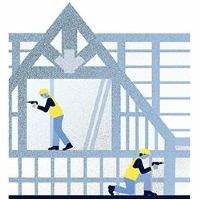Part of the solution to delivering more housing is to work the market harder, particularly in the south east. We need more large sites priced for the mass market buyer. But, with low interest rates contributing to a shrinking owner-occupier market, a major step change can only come through diversifying products and tenures.
We examine six issues that will influence future demand and delivery
.png)
Stability needed to support increased delivery
The easiest way of finding people to live in new homes is to take households from local authority housing registers through delivering affordable housing. But, funding for affordable housing providers to develop or acquire new stock is capricious. Annual affordable housing delivery fell by 52% following the end of the Affordable Homes Programme 2011-2015. This volatility is not helpful in building stable supply chains.
On page 100 of the Housing White Paper, there are eight different definitions of affordable housing. One of them is Starter Homes, which is nearly three years old as a policy, but none have been built.
Stability of policy around the core affordable tenures of discounted rental products and shared ownership is more likely to support increased delivery.
2. Funding and finance
.png)
Simpler access to government finance can ease the process of getting large sites into production
Funding is much less of a constraint on development compared to just after the global financial crisis (GFC). Financing development is currently not a problem in most situations. The challenge comes on larger sites with the impact that heavy, upfront infrastructure needs have on cash flow.
The Homes and Communities Agency (HCA) plays a valuable role in unlocking capacity through a range of schemes, including the build-to-rent fund, housing infrastructure grant, finance for smaller housebuilders, and funding works for accelerating big costly sites.
Ebbsfleet, an example of the type of large site we need to see more of, has needed a range of funding solutions to kick-start development. This included £275 million to spend on infrastructure from the 2015 Budget and, more recently, a £30 million investment from UK Power Networks in electricity. But it has been a complex process, and simpler access to government finance can only ease the process of getting large sites into production.
The UK development market also presents an attractive opportunity for international capital to invest in land and development. For many, the focus has been on London, but as the prime market there became overcrowded, some have shifted their attention to Manchester and Birmingham. Others have entered the regional markets directly, such as YTL at Filton in Bristol.
3. Built to rent
.png)
A model that increases the supply of quality homes
The growth of market rented housing at the expense of owner occupation suggests that build to rent should be a substantial contributor to increased housebuilding.
Nationally, there are around 17,000 completed build-to-rent units, 24,000 under construction, and 55,000 in planning. Schemes have been successfully delivered across the country. Some have been headline-grabbing luxury apartment blocks, but many have been standard mass market housing, and this is where the potential to scale-up lies.
Our analysis for the British Property Federation (BPF) showed that build to rent is most successful at providing additional housing on large sites, where the accelerated market absorption leads to faster build-out rates. But this emerging sector has faced competition for land from build-to-sell developers.
The requirement proposed in the Housing White Paper for local authorities to proactively plan for rented housing will bring to the fore the challenge for policymakers and landowners to balance delivery with land value.
4. Development capacity
.png)
Small and medium-sized housebuilders are growing in their ambition
The tone of annual reports suggests that the major housebuilders are focusing on controlled growth rather than major expansion, alongside a determination to protect margins (which, on average, have reached a 25-year high).
There are exceptions. Galliford Try plans to grow more in the next five years than it has over the past five. But someone else needs to lead the next round of housebuilding growth.
Small and medium-sized housebuilders have started to emerge from the doldrums over the last two years. In the last year, 89% more plots were sold to small housebuilders and 22% more plots were sold to medium-sized housebuilders (see Q2 Land Market in Minutes). Medium-sized housebuilders are growing in their ambition and buying larger sites, particularly of 100-250 plots. Housing associations have the money and enthusiasm to become bigger players in the development industry (see Releasing Untapped Potential for More Housing). The National Housing Federation’s ambition is for the sector to build 120,000 homes per year by 2035, up from 40,000 in 2015/16.
However, most do not have widespread access to land (L&Q being one of several exceptions) and they mostly don’t have their own construction capacity. That’s why 82% would like to form a partnership with a developer within the next five years, and 80% would like to partner with a local authority, recognising the potential role of public land in providing more homes (see Savills Housing Sector Survey 2017).
5. Housing for older people
.png)
As the UK’s population ages, suitable housing for older people is a pressing need
Our analysis shows that the current supply of housing targeted at older households averages 7,200 homes per year. However, the number of households headed by people aged 75 and over will increase by 150,000 per year until 2022, according to Office for National Statistics (ONS) projections.
Older households hold substantial housing equity. The 65-plus age group own 43% of the total value of UK housing. But most housing targeted at this group is in the social housing sector, built for rent at a time when older households were much less likely to own their homes. Much of this housing has aged badly and is no longer fit for purpose.
This is a large and growing group of potential buyers, and there is a great opportunity to be building more housing targeted at them on appropriate sites.
6. Skills and materials
.png)
Brexit’s impact on build costs and skilled labour could push modern methods of construction into the mainstream
The availability and cost of labour and materials have ticked up as constraints to development in the HBF Surveys following the vote to leave the EU. Higher inflation, a weaker pound, and difficulty in sourcing migrant labour post-Brexit are a challenge to delivering 300,000 homes per year through traditional construction techniques.
Modern methods of construction (MMC) is often mooted as a solution, but has not really gained traction as a volume product. Around 10% of new homes in England were built via timber frame construction over the past three years, about the same proportion as a decade before. There is significant potential for this to be expanded, as more than 70% of the components of a traditional build can now be manufactured offsite.
Brexit’s impact on build costs and the huge question mark it throws up regarding access to skilled European labour could be the trigger required to push MMC into the mainstream.
Offsite manufacturing can draw on people with factory experience from other industries, instead of having to rely on a small pool of skilled tradespersons. It is also a potential solution for developers without their own construction capacity, including many housing associations and local authority housing companies.
The further benefit of MMC is that it brings more certainty to the development process. An NHBC survey in 2016 found that, for the major developers, the primary motivation for using MMC was a faster build program, and improved site efficiency.
Where MMC has been adopted by housebuilders, they have primarily used panelised systems. There has been limited adoption of fully volumetric systems. Most of the homes delivered by this method have been flats in London and the south east. However, there are several companies aiming to expand in this area. Live Verde, for example, has ambitions for five factories in the UK producing 25,000 units per year by 2022.


